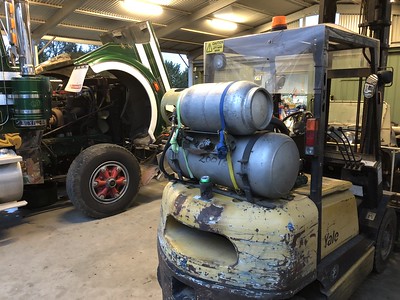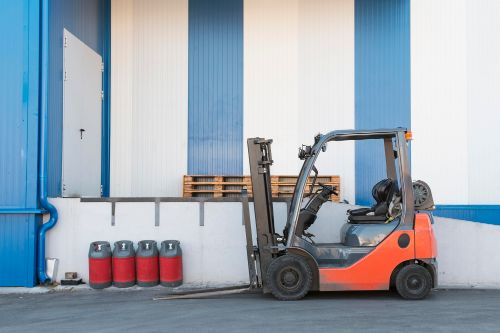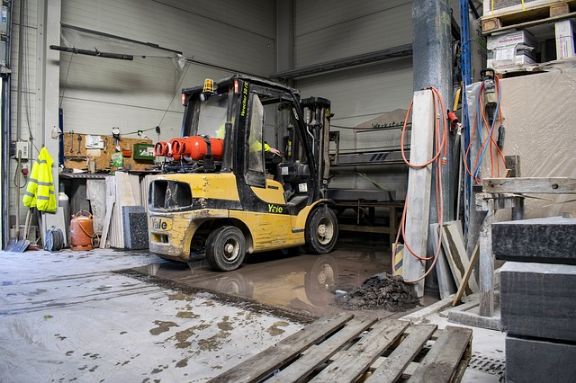
From my hands-on experience with forklift propane tanks, I’ve observed that these tanks generally have a lifespan of about 10 to 20 years. This duration can fluctuate based on usage intensity, maintenance practices, and storage conditions. I make it a point to conduct regular inspections, looking for any signs of wear such as rust or dents, which are red flags in terms of tank integrity.
In terms of maintenance, I focus on keeping the critical components like valves and connectors in top shape. Replacing any part that shows even minor signs of wear is essential for safety and efficiency.
Adhering to the specific local safety regulations, which often mandate periodic testing and set guidelines for replacement intervals, is a non-negotiable aspect of handling these tanks. For example, some regulations might require pressure testing every 5 or 10 years.
Storage plays a pivotal role in extending the tank’s life. I’ve found that storing tanks in environments that are well-ventilated and shielded from extreme temperatures can significantly impact their longevity.
When a tank nears or exceeds the 10-year mark, I start considering replacement. In this field, erring on the side of caution is a practice that pays off in terms of safety and uninterrupted operations.
Read related article: What Size of Tank Does the Forklift Tank?
Factors Influencing Lifespan
Of the factors that influence the lifespan of a forklift propane tank, two primary elements stand out: environmental factors and usage intensity.
- Environmental Factors Affecting Tank Durability:
- Exposure to Corrosive Environments: Propane tanks exposed to corrosive substances like chemicals or salt (common in coastal areas) tend to degrade faster. For instance, if a tank is regularly exposed to saltwater spray, its metal components might start corroding within 5 years, as compared to the usual 10-20 years in non-corrosive environments.
- Temperature Fluctuations: Tanks exposed to extreme temperature changes, especially in regions with significant temperature variations between seasons, may experience increased stress on the metal, leading to potential cracking over time.
- UV Radiation: Continuous exposure to UV radiation can degrade the exterior paint and protective coatings of a tank, making it more susceptible to rust and corrosion.
- Impact of Usage Intensity on Tank Lifespan:
- Continuous vs. Intermittent Use: Tanks used continuously, especially in industrial settings where they are refilled often, tend to wear out faster. The stress from constant pressurization and depressurization can lead to metal fatigue. For example, a tank used daily might show signs of wear within 10 years, whereas one used intermittently could last up to 20 years.
- Handling Practices: Tanks that are frequently moved or handled roughly may develop structural weaknesses faster than those treated more gently. Improper handling can lead to micro-fractures or deformations that compromise the tank’s integrity.
Understanding these specific factors and how they impact the tank’s condition can help in better maintenance and timely replacement, ensuring both safety and efficiency in forklift operations.
What Are the Signs That a Forklift Propane Tank Needs to Be Replaced?
Recognizing the signs that a forklift propane tank needs replacement is crucial for maintaining safety and efficiency in operations. Here are key indicators:
- Expiration Date: Each tank has a manufacturer’s label with an expiration date. If the tank has reached or is close to this date, it’s time for a replacement.
- Visible Damage: Look for signs like dents, rust, or corrosion. Any visible damage can compromise the structural integrity of the tank.
- Leaks: If you smell propane near the tank or notice a hissing sound, it could indicate a leak. This is a serious safety concern and typically means the tank needs to be replaced.
- Faulty Valves or Connections: Check the valves and connections. If they are damaged or not functioning properly, it can be a sign that the tank is no longer safe to use.
- Irregularities During Refilling: Difficulty in refilling the tank, or unusual occurrences during the refilling process, can indicate internal issues.
- Changes in Forklift Performance: If the forklift starts showing inconsistent performance or fuel efficiency issues, it could be related to a faulty propane tank.
- Certification and Compliance Issues: If the tank no longer meets the industry standards or fails a certification test, it must be replaced.
It’s important to have these tanks inspected regularly by qualified personnel and to adhere to all safety guidelines and regulations. When in doubt, consult a professional to assess the tank’s condition.
Signs of Aging Specific to Propane Tanks
Identifying subtle signs of aging in propane tanks is key to ensuring safety and efficiency. Here are specific indicators, along with relevant measurements, that suggest a propane tank is nearing the end of its useful life:
- Thickness Reduction: Over time, the walls of a propane tank may thin due to corrosion or wear. If measurements show a wall thickness reduction of more than 10% from its original specification, it’s a clear sign of aging.
- Rust and Corrosion: Small patches of rust might not be immediately alarming, but extensive rusting, especially if it penetrates the surface and reduces the material thickness significantly, indicates aging. For example, any area where rust has caused a reduction in wall thickness by 1/16th of an inch or more is a concern.
- Stress Cracks: Look for hairline cracks, especially around welded areas. These can be less than a millimeter wide but indicate material fatigue. Tanks with visible stress cracks should be inspected by a professional and likely replaced.
- Fading or Damaged Labels: While this might seem superficial, labels contain crucial safety and compliance information. Fading or damage to the point where labels are illegible, typically after several years of exposure, suggests the tank has been in use for a considerable duration.
- Valve or Connector Wear: Examine for wear or damage to valves and connectors. For instance, if the valve threads show more than 0.5 mm of wear, or if connectors are no longer fitting snugly, it’s a sign of aging and potential safety hazard.
- Changes in Sound or Smell during Refilling: If there are unusual sounds (like hissing) or smells during refilling, this could indicate internal issues such as valve failures or cracks, often occurring in tanks older than 10 years.
- Irregular Pressure Readings: Tanks exhibiting inconsistent or abnormal pressure readings, which might start happening after 10-15 years of use, can indicate internal degradation.
Regularly monitoring these specific signs can help in determining when a tank is approaching the end of its safe and functional lifespan, guiding timely replacement decisions.
How Can You Extend Its Lifespan?
One way to extend the lifespan of a forklift propane tank is to ensure that it is properly filled. This can be done by checking the level of propane in the tank regularly and refilling it when necessary. It is also important to keep the tank clean and free of debris, as this can clog the valve and prevent the propane from flowing properly. Finally, it is a good idea to have the tank inspected regularly by a qualified technician to ensure that it is in good working condition.
Forklifts that use propane tanks can last for a very long time, provided that the tank is well-maintained. The lifespan of a propane tank will depend on a few factors, such as how often it is used, how it is stored, and how well it is taken care of. With proper care, a propane tank can last for many years.
One of the most important things to do in order to prolong the lifespan of a propane tank is to make sure that it is always stored in a cool, dry place. If the tank is exposed to extreme heat or cold, it can cause the metal to weaken and eventually fail. It is also important to keep the tank full, as this will help to prevent corrosion.
In addition to proper storage, it is also important to inspect the tank regularly for any signs of damage. If any cracks or leaks are found, the tank should be repaired or replaced immediately. By following these simple tips, you can help to ensure that your propane tank has a long and healthy lifespan.
What Are the Risks of Using a Forklift Propane Tank for Too Long?
Using a forklift propane tank for too long, beyond its intended lifespan or safe usage period, poses several significant risks:
- Risk of Leaks and Explosions: An overused or aged tank is more susceptible to leaks due to weakened structural integrity. Propane leaks are not only highly flammable but can also lead to explosions, posing a severe hazard to personnel and property.
- Increased Risk of Fires: Even a small leak in a propane tank can lead to a fire, especially in environments where forklifts operate near combustible materials or in enclosed spaces.
- Decreased Efficiency and Performance: An old tank may not deliver propane efficiently, leading to performance issues with the forklift. This can result in higher fuel consumption and reduced operational efficiency.
- Potential for Valve and Seal Failures: With prolonged use, the valves and seals of the tank can deteriorate, which might lead to propane escaping unexpectedly. This can cause sudden operational failures and pose safety risks.
- Compliance and Legal Issues: Using tanks beyond their recommended lifespan can violate safety regulations and standards, potentially leading to legal repercussions and fines.
- Increased Maintenance Costs: Older tanks often require more frequent inspections and maintenance, leading to increased operational costs.
- Environmental Hazards: Leaking propane is not only a fire hazard but also a pollutant. If it seeps into the ground, it can contaminate the soil and water sources.
Therefore, it is crucial to adhere to recommended usage timelines and replace forklift propane tanks as needed to ensure safety, efficiency, and compliance.
Proper Storage For Forklift Propane Tanks
Here are some key storage solutions that a technical expert can recommend:
- Climate-Controlled Storage: Storing tanks in a climate-controlled environment can prevent extreme temperature fluctuations that contribute to material stress and corrosion. Maintaining a consistent temperature, ideally between 50°F and 80°F, can significantly extend the tank’s lifespan.
- Elevated and Secure Racking Systems: Using customized racking systems that keep propane tanks elevated helps prevent ground moisture and potential flooding from affecting the tanks. These systems also secure the tanks from accidental knocks or falls.
- Corrosion-Resistant Coatings: Applying corrosion-resistant coatings to tanks, especially in high humidity or corrosive environments, can protect against rust and corrosion. These coatings can be reapplied periodically to maintain their effectiveness.
- Automated Monitoring Systems: Implementing automated systems to monitor the condition of tanks can be a game-changer. These systems can track temperature, humidity, and other environmental factors, providing alerts for any conditions that might adversely affect the tanks.
- UV Protection: Tanks are often exposed to sunlight, which can degrade their exterior over time. Using UV-protective covers or storing tanks in shaded areas can prevent this degradation.
- Rotation System: If you have multiple tanks, implementing a rotation system ensures that no single tank is exposed to wear and tear continuously. Regularly rotating tanks in and out of service can evenly distribute usage and extend their overall lifespan.
- Regular Cleaning and Maintenance: Regularly cleaning the tanks to remove dirt, grime, and residues can prevent long-term damage. Also, inspecting for and repairing minor damages like paint chips or small dents can prevent them from developing into larger issues.
By integrating these innovative storage solutions, you can significantly enhance the longevity of forklift propane tanks, ensuring they remain safe and functional for extended periods.
Maintenance and Inspection Specifics
In the technical field of maintaining forklift propane tanks, specialized maintenance practices and rigorous inspection protocols are key to extending the tanks’ lifespan. Here’s a detailed breakdown:
Specialized Maintenance Practices:
- Regular Surface Treatments: Applying anti-corrosive treatments to the tank’s exterior can prevent rust and corrosion. This includes using rust-inhibiting paints or coatings, especially in environments prone to moisture or chemical exposure.
- Valve and Regulator Maintenance: Regularly inspect and maintain the tank’s valves and regulators. This involves checking for leaks, ensuring smooth operation, and replacing any parts showing signs of wear or damage.
- Seal Replacements: Propane tank seals can degrade over time. Inspecting and replacing these seals periodically is crucial to prevent leaks.
- Cleaning Protocols: Implement a regular cleaning schedule to remove dirt, grime, and chemical residues that can corrode the tank’s surface. Specialized cleaning agents may be required for certain types of residues.
Professional Inspection Frequency and Types:
- Annual Inspections: At a minimum, forklift propane tanks should undergo a professional inspection annually. This goes beyond basic visual checks and includes detailed assessments of the tank’s integrity and functional components.
- Pressure Testing: Every 5 to 10 years (as per regulatory standards), tanks should undergo pressure testing, also known as hydrostatic testing, to ensure they can safely hold propane under operating conditions.
- Ultrasonic Testing: For more detailed analysis, ultrasonic testing can be used to detect internal and external flaws, such as cracks or wall thinning, that aren’t visible to the naked eye.
- Leak Detection Tests: Regular leak detection tests should be performed using specialized equipment. This is crucial for identifying even the smallest leaks that might not be apparent during a visual inspection.
- Compliance Checks: Inspections should also verify that the tank complies with current safety and environmental regulations.
By adhering to these specialized maintenance practices and ensuring regular professional inspections, the lifespan of forklift propane tanks can be significantly extended, ensuring they remain safe and efficient for their intended use.
To Wrap This Up
The lifespan of a forklift propane tank is a multifaceted issue that hinges on diligent maintenance, proper handling, and adherence to safety standards. While these tanks are designed for durability, their longevity can be greatly influenced by environmental conditions, usage intensity, and the quality of care they receive.
Regular inspections and maintenance, including specialized practices like surface treatments and valve maintenance, play a pivotal role in extending a tank’s lifespan. Moreover, understanding and responding to the subtle signs of aging, such as rust, corrosion, or changes in performance, is crucial for timely replacements.
Professional inspections, which go beyond mere visual checks, are essential in detecting issues that might not be immediately apparent but could significantly impact the tank’s safety and functionality. These include pressure testing, ultrasonic examinations, and leak detection, ensuring that the tanks meet both operational and regulatory standards.
In essence, the proactive approach towards maintenance, inspection, and compliance will not only extend the life of these essential components but also ensure the safety and efficiency of forklift operations. By respecting the intricate balance between usage, care, and safety, businesses can effectively manage the lifespan of their forklift propane tanks, maximizing their investment while upholding the highest standards of operational safety.

Mike is an experienced propane technician with over 15 years of professional experience in the field. He has dedicated his career to helping customers with their propane needs, from installation to maintenance and repair. Together with Jeremy, he co-founded this website to provide useful information and guidance to customers seeking reliable propane services.



